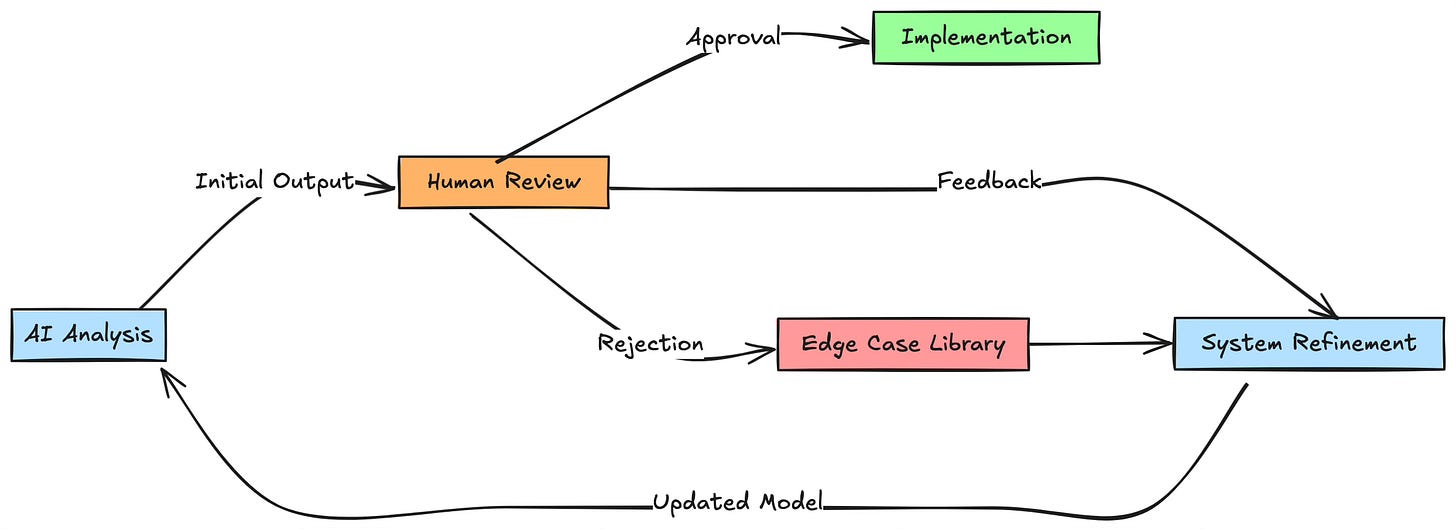The AI trap most organisations fall Into: How to blend human wisdom with AI power
Avoid the biggest AI implementation mistake. Learn how to blend human oversight with AI to boost efficiency and accuracy in enterprise environments.
Quick Take (30-second read):
After 20 years in enterprise tech, I've seen firms waste money on AI without guardrails.
The result? Quite a complex mess.
Let me explain how I have blended AI's smarts with human wisdom. I base this on real projects I've overseen. You'll see a way to keep humans in the loop, without bottlenecking AI systems.
AI implementations are a mess, and as hard as herding cats in a thunderstorm. I've seen more botched rollouts than I care to count. Here's the kicker, though: nearly all failed for the same reason.
Company executives treat AI like a 'silver bullet'.
“My biggest lesson from these failures: AI without human oversight is like a junior dev with admin access to production systems.”
Sure, it might work brilliantly... until it doesn't. And when it doesn't, executives start to sweat!
The Secret Sauce: Human-AI Harmony
I'll share a trade secret. The best AI projects treat the system like a brilliant but inexperienced team member.
Would you let a fresh graduate rewrite your core infrastructure?
The same principle applies here.
Let me break down exactly how this works in practice:
Clear Boundaries.
Clear Results.
Every AI system needs proper guardrails.
I recently assisted a healthcare provider in setting up their patient referral duplication AI. The system was brilliant at spotting patterns.
But we made sure a human checked every high-stakes decision.
The Result? 60% reduced duplicated referrals, faster processing with zero critical errors. Let’s dive a little deeper into this real-world problem.
Real-world implementation that works
Here's where the rubber hits the road. I'll share how I've done this in proper enterprises: Start with the Mundane. Begin with low-risk, high-volume tasks.
We began our AI journey by classifying internal documents to define what constitutes a good referral. We kept pharmacists and nurses informed, but focused their time on the more complex cases.
Starting with the clinical and regulatory process, we enabled 80% automation of basic referral work within three months. This improved accuracy by 35%.
By building Learning Loops, every human intervention should feed back into the system, allowing for continuous improvement. Returning to our junior developer analogy, it's like training them to help correct a whole system, making it smarter.
Measure What Matters
Don't just track speed - track the human quality improvements as well. Here's what I measure:
Error reduction rates.
Human intervention frequency.
System learning speed.
Cost per decision.
Quality improvement over time.
The proof's in the pudding. Let me share some real numbers (because I'm a proper dyslexic nerd like that):
✅ Our patient referral duplication mitigation
Before: On an average day, 57 patient referrals were checked. 30-50 minute average response to check for duplications across four systems
After: Improved average of 179 patient referrals checks. 15-20 minute average human oversight response to check duplications. Four systems are now aggregating into one system. Reduced from 100% to 40% of patient referral cases
Accuracy: Improved from 57% to 92% with zero critical errors.
Start checking your homework
If you're concerned about your AI's black box, it's time to evaluate its performance.
Here's my quick guide checklist to get you started:
Goal: Audit your current AI implementations.
Identify human checkpoint opportunities.
Design your feedback loops.
Start small, identify what to measure from the feedback loops.
Scale what works, bin what doesn't.
In my next weekly article, I'll dive into my playbook, where you can explore the technical details of setting up those feedback loops.
I'll share real feedback loops, the exact metrics I tracked.
Key Takeaways
🎯 Human Oversight Isn't Optional: Your AI needs guardrails, just like a junior developer needs code review. Build it into your process from day one.
🔄 Feedback Loops Are Everything: Every human intervention should make your system smarter. Learning design, not just doing.
📈 Measure, Adjust, Repeat: Track everything, but focus on metrics that matter to your business outcomes.
💡 Start Small, Scale Smart: Begin with low-risk, high-volume tasks and expand based on proven success.
Until next time, Tim
P.S.
What's your biggest challenge with AI implementation? Drop a comment below - I read and respond to every one.





